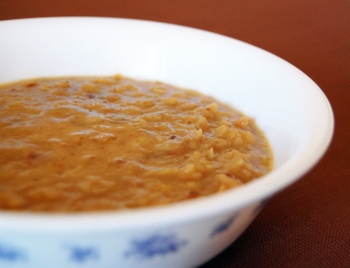 Roasted Pigeon Peas and Spicy Tomato Rasam
Roasted Pigeon Peas and Spicy Tomato Rasam
Lentils play a prominent role in my everyday cooking. As a vegetarian, for me they are the protein pack filled with valuable nutrients and vitamins besides vegetables. Dishes made of lentils are must in my everyday cooking. It can be dal, rasam, sambar or even chutney. There are lots of different varieties of lentils available and each one has a distinctive flavor and used in preparation of different kinds of delicious dishes. In India lentils are used extensively right from side dishes to savories and deserts.
In India, toor dal (split pigeon peas) are one of the most popular lentils—along with, chana, urad, masoor and mung. Pigeon peas are nutritionally important, as they contain high levels of protein and the important amino acids methionine, lysine, and tryptophan.
As a South Indian I’m very fond of toor dal/kandi pappu (split pigeon peas), urad dal (black gram), channa dal (split chickpeas) and moong dal (slit yellow mung beans) and my pantry is always well stocked with all these different lentils and legumes, looks more like an mini lentil bazaar.
When it comes to cooking time by default I go for toor dal (Kandi pappu in Telugu). When Linda announced that she is extending the deadline for JFI- Toor dal, I have decided to send my favorite mudda pappu .The nutty flavor of the roasted toor dal gives a unique taste to the dish. Mudda pappu is relished with different combinations. Today’s combination is with simple tomato rasam and potato fry. When ever I cook this dish, it takes back to my childhood days. My mom always use to make small balls of dal rice and drop them into the spicy hot rasam and use to me feed and my sister telling us all those beautiful moral stories.
our meal today mudda pappu, tomato rasam and potato fry
Thanks Linda, I’m sending this to you .
Mudda Pappu
Ingredients
1 cup toor dal/ kandi pappu
Salt to taste
Water to cook
Procedure
Heat a dry skillet on medium low, dry roast toor dal till golden brown and until you smell the nutty aroma of roasted dal. Remove from heat, shift into a bowl. Add required amount of water and pressure cook until done (I usually cook for 3 whistles). Cool down and drain the excess water into a bowl (don’t throw it). Lightly mash the dal and mix salt and little reserve water to thin it /desired consistency.
Tomato Rasam/Charu
Call it a “Soup” in western style or “Rasam” in Indian way. It’s a comfort food for many Indians especially South Indians. There are a lot of different varieties of Rasam, they are good for tummy and also yummy side dish for rice usually had along with dal, dry curries and papad. This is a simple version of no dal tomato rasam.
Ingredients:
1 small tomato
Tamarind (small lemon size)
1 tsp jaggery
2 cups water / reserved lentil water
1/4 tsp turmeric
Few curry leaves
Salt to taste
For seasoning
1 tsp veg oil
1/2 tsp jeera
1/4 tsp mustard seeds
Pinch of hing
2 tsp MTR rasam powder
Few coriander leaves (chopped)
Heat oil in a small frying pan and fry the seasonings 1-4 (except rasam powder and coriander leaves). Allow mustard seeds to pop. Turn off the heat and keep aside.
Procedure
Soak tamarind in warm water for 15 mins and extract the pulp (around 2-3 tbsp)
In a deep pan/ pot, add the tomatoes (crush or chopped) , tamarind pulp, salt, turmeric, jaggery, curry leaves and water. Bring all together to boil and reduce the heat to low. Cook the rasam mixture for 10-12 minutes or until the tomatoes are soft and done. Add rasam powder and cook for 2 more minutes. Adjust the taste, stir in the seasoning and coriander leaves and remove from heat.
To serve (like my mom) , mix rice, ghee (clarified butter) and mudda pappu and make balls. In a soup bowl pour rasam and drop the dal rice balls as shown in the above picture. Let it stand for 3-5 mins and enjoy listening to a nice story. 🙂
Notes and Tips
You can make mudda pappu without roasting dal. You can use sugar instead of jaggery in your rasam. If you don’t like the sweetness in your rasam just skip the sugar/jaggery. Rasam powder can be substituted with ½ tsp of coriander powder and ¼ tsp of red chilli powder. Add these ingredients to seasoning and fry for a minute or so and mix. Toor dal/ pigeon peas is also know as tuvar dal, red gram , arahar dal.
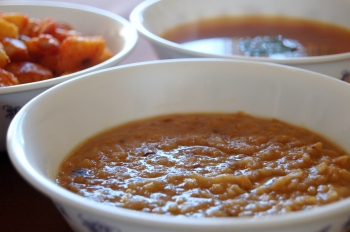
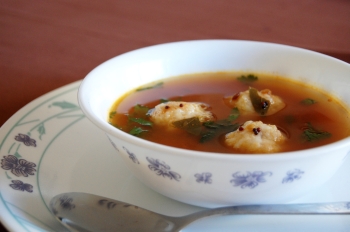
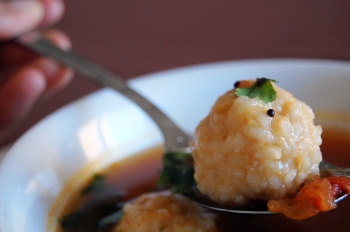
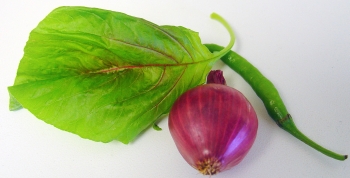

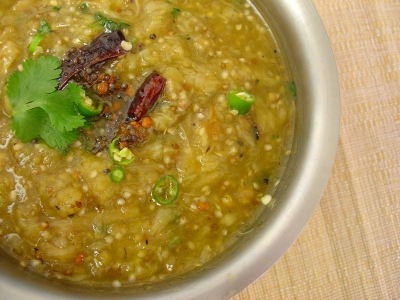
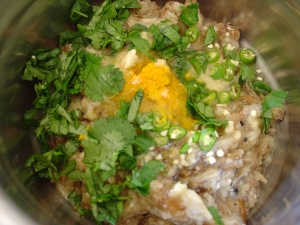
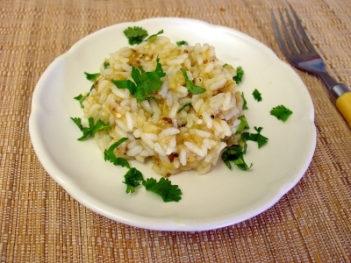











Recent Comments